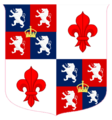Harbord Harbord, 1st Baron Suffield facts for kids
Quick facts for kids
The Lord Suffield
|
|
|---|---|

Sir Harbord Harbord by Thomas Gainsborough, 1783 (Norwich Castle Museum)
|
|
| Member of Parliament for Norwich (with Edward Bacon to 1784; with William Windham from 1784) |
|
| In office 1756–1786 |
|
| Preceded by | Lord Hobart and Edward Bacon |
| Succeeded by | William Windham and Henry Hobart |
| Personal details | |
| Born |
Harbord Morden
26 January 1734 Thorpe St Andrew, Norfolk |
| Died | 4 February 1810 (aged 76) |
| Nationality | British |
| Political party | Tory |
| Spouse | Mary Assheton |
| Children | William, Edward |
| Parents |
|
| Residence | Gunton Hall |
Harbord Harbord, 1st Baron Suffield (born January 26, 1734 – died February 4, 1810) was an important British politician and landowner. He was also known as Sir Harbord Harbord. He served in the House of Commons, which is like a part of the UK Parliament, for many years. Later, he was given the special title of Baron Suffield.
Contents
Early Life and Family Name
Harbord Harbord was born as Harbord Morden in a place called Thorpe St Andrew in Norfolk, England. He was the oldest son of William Morden and Elizabeth Britiffe. His mother's father, Robert Britiffe, was a "Recorder" in Norwich, which means he was a judge.
In 1742, Harbord's father changed the family name from Morden to Harbord. This happened because of a will from his mother's uncle, who was also named Harbord Harbord.
Political Career and Home Improvements
Harbord Harbord became a Member of Parliament (MP) for Norwich in 1756. He served as an MP for a long time, until 1786.
In 1770, he inherited the title of "Baronet" from his father. This meant he was then known as Sir Harbord Harbord.
In 1775, he hired a famous architect named James Wyatt. Wyatt helped to make big improvements to the family's country home, Gunton Hall.
Becoming a Lord and Family Legacy
In 1786, Harbord Harbord was given a very high honor. He was made a "peer," which meant he became a member of the nobility. He was given the title Lord Suffield, Baron of Suffield, in Norfolk.
Lord Suffield married Mary Assheton in 1760. She was the daughter of Sir Ralph Assheton.
He passed away in February 1810 when he was 76 years old. His oldest son, William, inherited his titles. His younger son, Edward, also became a politician. Edward was known for being a strong supporter of ending slavery.
Images for kids




